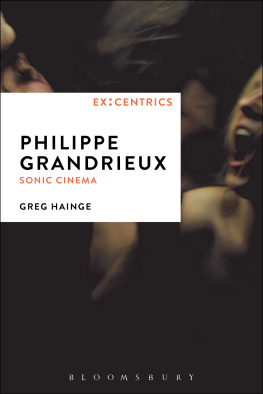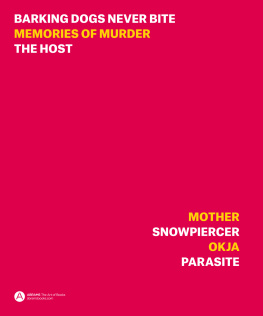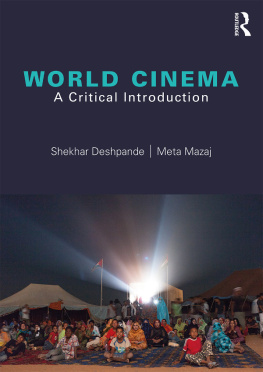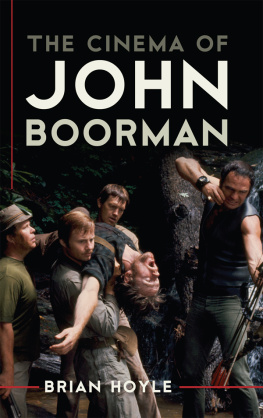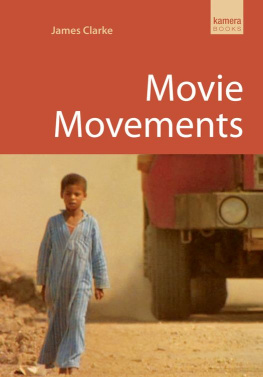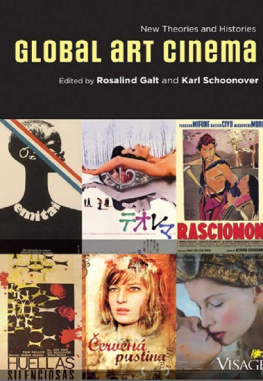Philippe Grandrieux
ex:centrics
Series Editors:
Greg Hainge and Paul Hegarty
Philippe Grandrieux
Sonic Cinema
Greg Hainge
Bloomsbury Academic
An imprint of Bloomsbury Publishing Inc

CONTENTS
Screenshot from Via la vido . Courtesy Philippe Grandrieux |
Screenshot from Une Gnration . Courtesy Philippe Grandrieux |
Screenshot from Retour Sarajevo . Courtesy Philippe Grandrieux |
Screenshot from Sombre . Courtesy Mandrake Films |
Screenshot from Sombre . Courtesy Mandrake Films |
Screenshot from La Vie nouvelle . Courtesy Mandrake Films |
Screenshot from La Vie nouvelle . Courtesy Mandrake Films |
Screenshot from La Vie nouvelle . Courtesy Mandrake Films |
Screenshot from La Vie nouvelle . Courtesy Mandrake Films |
Screenshot from Met . Courtesy Philippe Grandrieux |
Screenshot from LArrire-saison . Courtesy Philippe Grandrieux |
Screenshot from Un lac . Courtesy Mandrake Films |
Screenshot from Un lac . Courtesy Mandrake Films |
Screenshot from Un lac . Courtesy Mandrake Films |
Screenshot from Un lac . Courtesy Mandrake Films |
Screenshot from Il se peut que la beaut ait renforc notre rsolution Masao Adachi . Courtesy Epileptic |
Screenshot from White Epilepsy . Courtesy Epileptic |
Screenshot from Meurtrire . Courtesy Epileptic |
Screenshot from Malgr la nuit . Courtesy Mandrake Films |
Screenshot from Malgr la nuit . Courtesy Mandrake Films |
To thank the subject of the book one is writing could easily seem either a little too affected for comfort or else invoke the spectre of a troubling conflict of interest that points towards a lack of proper critical distance. The simple fact of the matter is, however, that this book would not exist were it not for the fact that the work of Philippe Grandrieux has been so personally inspiring to me and it is only right and fitting that I should acknowledge this and express my sincere appreciation and deep admiration for this. That a body of work such as this should continue to be produced today seems at times somehow miraculous and yet the very fact that it does keeps the embers of hope burning bright.
I must acknowledge also, however, that this work could never have been what it is without the direct assistance of Philippe Grandrieux and his close family, friends and collaborators. Work that takes place on the fringes of mainstream cultural production, as Grandrieuxs work so often has, can easily slip between the cracks of archival preservation, whether this is inscribed in the cultural imaginary of an epoch (for the mainstream), in institutional structures (for those products deemed worthy of the status of cultural heritage), or in the rarefied circuits of fandom and fetishism (for the underground). I am therefore indebted to and deeply grateful for the unprecedented access to certain archival and preparatory materials that have been granted to me by Philippe Grandrieux and Corinne Thevenon-Grandrieux. Annick Lemonnier, the producer of some of Grandrieuxs non-feature-length works produced for Epileptic, has also been an invaluable source of information and resources. I am, in addition, grateful to Boris Gobille for access to a deeply personal interview archive that never managed to see the light of day and to Nicole Brenez and Adrian Martin for putting things in front of me that I would not have found otherwise.
The dangers of a too close relationship to ones source material is best tempered by a second opinion, and for this reason I am especially grateful to Nicole Brenez, Jenny Chamarette, John Edmond, Paul Hegarty, Richard Iveson and Adrian Martin, all of whom read the manuscript and provided encouragement and a keen critical eye.
Over the years that this work has been in preparation, my energy has been sustained and my neurones fired by the support and exchange of ideas with very many people, too numerous to mention here, but some of whom need to be namechecked nonetheless for their specific contributions: Amelia Barikin, Raymond Bellour, Jo Connah, Mathieu Copeland, Lucio Crispino, Jose Da Silva, Gregory Flaxman, Emilia Giudicelli, Ferdinand Grandrieux, Randolph Jordan, Manuela Morgaine, James Philips, Vilma Pitrinaite, Phil Powrie, Hlne Rocheteau, Robert Sinnerbrink, Elizabeth Stephens, Lisa Trahair, Saige Walton, Kathryn Weir, Francesca Ziviani, thanks to you all. It is truly wonderful to have had the support of so many people who believe in the kind of work that Grandrieux does and who understand why we must fight to ensure its continued existence.
There is no way that this book could have been completed without the time afforded to me by a Faculty Fellowship in the Institute of Advanced Studies in the Humanities of the University of Queensland. This environment provided not only the time that a project like this demands, but also the intellectual environment needed to make work such as this much better and richer than it would have been otherwise; in saying this I have one name in particular in mind, and even though I have already thanked him for reading the manuscript, I need to acknowledge him again, because on so many occasions when I was babbling excitedly after a bout of writing frenzy, Richard Ivesons reading recommendations were always spot on.
I also want to thank Ally Jane Grossan who originally had the vision, energy and conviction to sign up the series that Paul and I proposed to her when she was working at Bloomsbury and for following our logic when we argued that a book on a film-maker was the ideal first volume in this new sound studies series. Since Ally Jane moved on to fresh pastures, Leah Babb-Rosenfeld has more than capably filled some very big boots and provided wonderful continuity and an incredible level of support and trust in what we are trying to achieve with this series.
The staff of lInstitut national de laudiovisuel (lINA) provided invaluable assistance in tracking down some of the works for television that were buried deep in their archives.
I am grateful for the copyright holders for permission to reproduce the images contained herein. Images from Via la vido , Une Gnration , Retour Sarajevo , L Arrire-saison and Met are reproduced with the permission of Philippe Grandrieux. Images from Sombre , La Vie nouvelle , Un lac and Malgr la nuit are reproduced with the permission of Mandrake Films. Images from Il se peut que la beaut ait renforc notre rsolution Masao Adachi , White Epilepsy and Meurtrire are reproduced with the permission of Epileptic.
And finally, I want to thank Jo, Elize, James and Juliette for supporting me always and completely, for understanding that when doing a project like this there are times when I need to be in lockdown, and for always being there when I emerge again.
In Shanghai Village Dumpling Restaurant, down an alley in Melbournes China Town, between mouthfuls of xiao long bao, our conversation turned to Bacon or, to be more precise, Gilles Deleuzes book on Bacon, Logic of Sensation (2003b). Thats the one, said Philippe Grandrieux excitedly, stabbing the air with his chopsticks. Thats the book where he [Deleuze] talks about the cinema more than any other. This statement puzzled me for a long time; how, I wondered, could a book on a painter be considered more relevant to the cinema than, most obviously, the two-volume work that Deleuze had penned about the cinema, titled, appropriately, Cinema (1986b and 1989)? The answer to this question only really became apparent to me years later, in Le Havre, where I found myself to see the latest performance directed by Grandrieux, Meurtrire [ Murderess ], and this book is, in many respects, an attempt to unpack that answer more fully through a consideration of Grandrieuxs entire artistic output to date.

